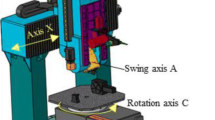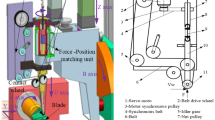Abstract
As a difficult-to-cut metallic material with excellent characteristics, titanium alloy has been widely used in the field of aero-engines. In this study, a series of grinding experiments of titanium alloy was carried out with the abrasive belt flap wheel. The effects of spindle speed n, feed speed Vw, workpiece curvature radius R2, and radial theoretical grinding depth ae on the material removal depth are investigated. Meanwhile, a noval approach to determine the depth of radial material removal was established based on the Hertz elastic contact theory, Preston equation, and the principle of equivalent material removal volume. The results obtained show that the radial material removal depth increases with the increase of the radial theoretical grinding depth and decreases with the increase of the workpiece curvature radius and the spindle speed, and the feed speed has almost no effect on it. Finally, the measured value is compared with the calculated value, and the absolute error is mostly less than 10%, which verifies the reliability and accuracy of the prediction model.








Similar content being viewed by others
Data availability
All data and materials generated or analyzed during this study are included in this published article.
References
Huang H, Gong Z, Chen X, Zhou L (2002) Robotic grinding and polishing for turbine-vane overhaul. J Mater Process Technol 127:140–145. https://doi.org/10.1016/S0924-0136(02)00114-0
Bigerelle M, Gautier A, Hagege B, Favergeon J, Bounichane B (2009) Roughness characteristic length scales of belt finished surface. J Mater Process Technol 209(20):6103–6116. https://doi.org/10.1016/j.jmatprotec.2009.04.013
Zhang T, Su J (2018) Collision-free planning algorithm of motion path for the robot belt grinding system. Int J Adv Robot Syst 15(4):172988141879377. https://doi.org/10.1177/1729881418793778
Ding Y, Min X, Fu W, Liang ZL (2018) Research and application on force control of industrial robot polishing concave curved surfaces. Proc Inst Mech Eng B J Eng Manuf. 233(6):1674–1686. https://doi.org/10.1177/0954405418802309
Tian F, Li Z, Lv C, Liu G (2016) Polishing pressure investigations of robot automatic polishing on curved surfaces. Int J Adv Manuf Technol 87(1-4):639–646. https://doi.org/10.1007/s00170-016-8527-2
Xiao G, Huang Y (2017) Experimental research and modelling of life-cycle material removal in belt finishing for titanium alloy. J Manuf Process 30:255–267. https://doi.org/10.1016/j.jmapro.2017.09.030
Zou L, Liu X, Ren X, Huang Y (2020) Investigation of robotic abrasive belt grinding methods used for precision machining of aluminum blades. Int J Adv Manuf Technol. https://doi.org/10.1007/s00170-020-05632-z
Hung P, Dung H, Trung N (2020) The study on surface grinding process of TI–6AL–4V alloy with resinoid cBN grinding wheel. Int J Mod Phys B 34:2040135. https://doi.org/10.1142/s0217979220401359
Shi Y, Chen L, Xin H, Yu T, Sun Z (2020) Investigation on the grinding properties of high thermal conductivity vitrified bond CBN grinding wheel for titanium alloy. Int J Adv Manuf Technol 107:1539–1549. https://doi.org/10.1007/s00170-020-05134-y
Dai C, Ding W, Zhu J, Xu J, Yu HW (2017) Grinding temperature and power consumption in high speed grinding of Inconel 718 nickel-based superalloy with a vitrified CBN wheel. Precis Eng 52:192–200. https://doi.org/10.1016/j.precisioneng.2017.12.005
Zhang Z, Wang B, Kang R, Zhang B, Guo D (2015) Changes in surface layer of silicon wafers from diamond scratching. CIRP Ann Manuf Technol 64(1):349–352. https://doi.org/10.1016/j.cirp.2015.04.005
Zhang Z, Guo D, Wang B, Kang R, Zhang B (2015) A novel approach of high speed scratching on silicon wafers at nanoscale depths of cut. Sci Rep-UK 5:16395. https://doi.org/10.1038/srep16395
Zhang Z, Huo Y, Guo D (2013) A model for nanogrinding based on direct evidence of ground chips of silicon wafers. Sci China Technol Sci 56(9):2099–2108. https://doi.org/10.1007/s11431-013-5286-2
Zhang Z, Huo F, Zhang X, Guo D (2012) Fabrication and size prediction of crystalline nanoparticles of silicon induced by nanogrinding with ultrafine diamond grits. Scr Mater 67(7-8):657–660. https://doi.org/10.1016/j.scriptamat.2012.07.016
Zhang Z, Song Y, Xu C, Guo D (2012) A novel model for undeformed nanometer chips of soft-brittle HgCdTe films induced by ultrafine diamond grits. Scr Mater 67(2):197–200. https://doi.org/10.1016/j.scriptamat.2012.04.017
Zhang Z, Huang S, Wang S, Wang B, Bai Q, Zhang B, Kang R, Guo D (2017) A novel approach of high-performance grinding using developed diamond wheels. Int J Adv Manuf Technol 91(9-12):3315–3326. https://doi.org/10.1007/s00170-017-0037-3
Zhang Z, Du Y, Wang B, Wang Z, Kang R, Guo D (2017) Nanoscale Wear Layers on Silicon Wafers Induced by Mechanical Chemical Grinding. Tribol Lett 65:132. https://doi.org/10.1007/s11249-017-0911-z
Zhang Z, Cui J, Wang B, Wang Z, Kang R, Guo D (2017) A novel approach of mechanical chemical grinding. J Alloys Compd 726:514–524. https://doi.org/10.1016/j.jallcom.2017.08.024
Zhang J, Shi Y, Lin X, Li Z (2017) Five-axis abrasive belt flap wheel polishing method for leading and trailing edges of aero-engine blade. Int J Adv Manuf Technol 93(9-12):3383–3393. https://doi.org/10.1007/s00170-017-0717-z
Huai W, Shi Y, Tang H, Lin X (2016) Prediction of surface roughness ratio of polishing blade of abrasive cloth wheel and optimization of processing parameters. Int J Adv Manuf Technol 90(1-4):699–708. https://doi.org/10.1007/s00170-016-9397-3
Huai W, Shi Y, Tang H, Lin X (2019) An adaptive flexible polishing path programming method of the blisk blade using elastic grinding tools. J Mech Sci Technol 33(7):3487–3495. https://doi.org/10.1007/s12206-019-0643-0
Zhang J, Shi Y, Lin X, Li Z (2017) Parameter optimization of five-axis polishing using abrasive belt flap wheel for blisk blade. J Mech Sci Technol 31(10):4805–4812. https://doi.org/10.1007/s12206-017-0928-0
Johnson KL (1985) Contact Mechanics. Cambridge University Press, New York
Chang WR, Etsion I, Bogy DB (1987) An elastic-plastic model for the contact of rough surfaces. J Tribol 109(2):257. https://doi.org/10.1115/1.3261348
Dražumerič R, Badger J, Roininen R, Krajnik P (2020) On geometry and kinematics of abrasive processes: the theory of aggressiveness. Int J Mach Tools Manuf 154:103567. https://doi.org/10.1016/j.ijmachtools.2020.103567
Preston FW (1927) The theory and design of plate glass polishing machines. J Soc Glas Technol 11(1):214–256
Rogelio L, Steven Y, Wu X, Xia P, David G (2007) Grinding force and power modeling based on chip thickness analysis. Int J Adv Manuf Technol 33(5-6):449–459. https://doi.org/10.1007/s00170-006-0473-y
Wang G, Zhou X, Meng G, Yang X (2017) Modeling surface roughness for polishing process based on abrasive cutting and probability theory. Mach Sci Technol 22(1):86–98. https://doi.org/10.1080/10910344.2017.1336629
Tian L, Fu Y, Xu J, Li H, Ding W (2015) The influence of speed on material removal mechanism in high speed grinding with single grit. Int J Mach Tools Manuf 89:192–201. https://doi.org/10.1016/j.ijmachtools.2014.11.010
Drazumeric R, Badger J, Krajnik P (2014) Geometric, kinematical and thermal analyses of non-round cylindrical grinding. J Mater Process Technol 214(4):818–827. https://doi.org/10.1016/j.jmatprotec.2013.12.007
Funding
This work was supported by the National Natural Science Foundation of China (Grant No.51405304).
Author information
Authors and Affiliations
Contributions
Gang Zheng put forward the method and thought of establishing the theoretical model.
Keyan Chen conducted experiments and data collection, and wrote the paper.
Xiaojian Zhang participated in the modeling and experiment together, and provided the experimental conditions.
Xu Zhang revised the paper.
Corresponding author
Ethics declarations
Ethics approval
Not applicable.
Competing interests
The authors declare no competing interests.
Additional information
I would like to declare on behalf of my co-authors that the work described was original research that has not been published previously, and not under consideration for publication elsewhere, in whole or in part.
Publisher’s note
Springer Nature remains neutral with regard to jurisdictional claims in published maps and institutional affiliations.
Rights and permissions
About this article
Cite this article
Zheng, G., Chen, K., Zhang, X. et al. Theoretical modeling and experimental research on the depth of radial material removal for flexible grinding. Int J Adv Manuf Technol 116, 3355–3365 (2021). https://doi.org/10.1007/s00170-021-07535-z
Received:
Accepted:
Published:
Issue Date:
DOI: https://doi.org/10.1007/s00170-021-07535-z




